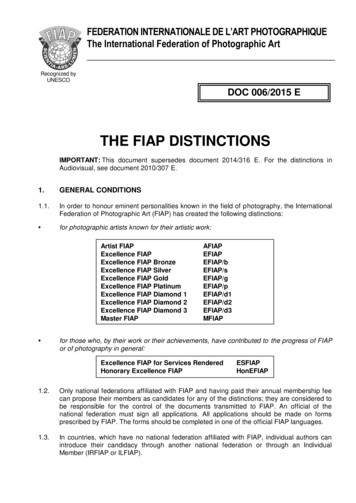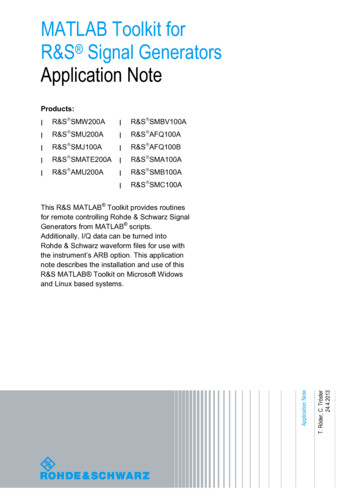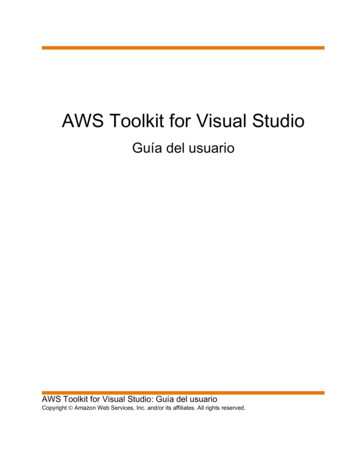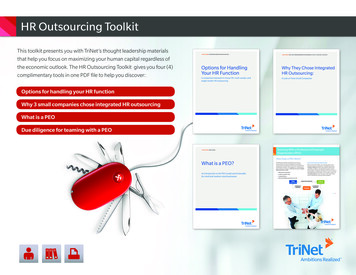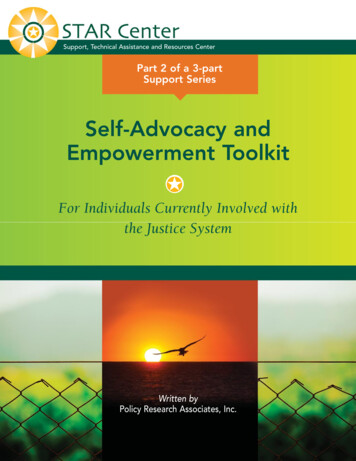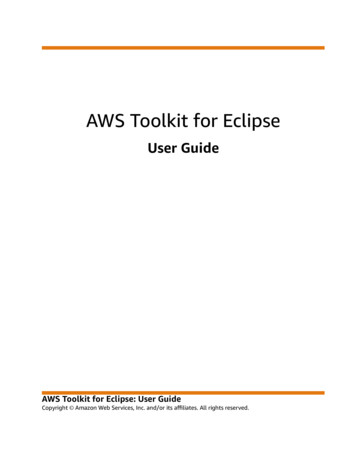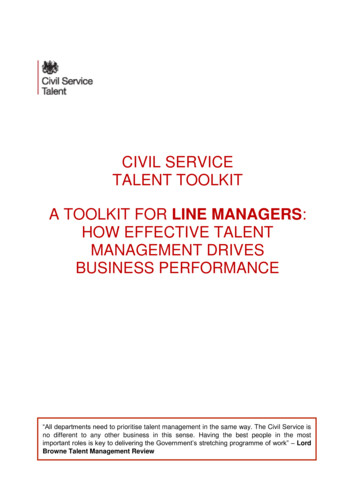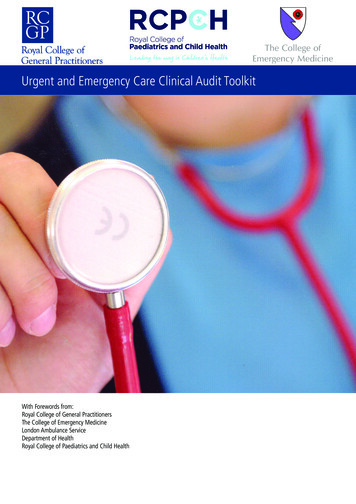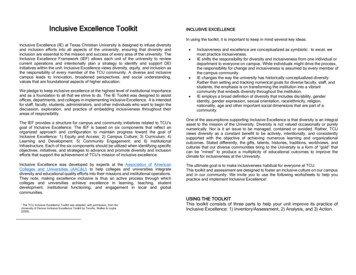
Transcription
Inclusive Excellence ToolkitINCLUSIVE EXCELLENCEIn using the toolkit, it is important to keep in mind several key ideas:Inclusive Excellence (IE) at Texas Christian University is designed to infuse diversityand inclusion efforts into all aspects of the university, ensuring that diversity andinclusion are essential to the mission and success of every area of the university. TheInclusive Excellence Framework (IEF) allows each unit of the university to reviewcurrent operations and intentionally plan a strategy to identify and support DEIinitiatives within the unit. Inclusive Excellence views diversity, equity, and inclusion asthe responsibility of every member of the TCU community. A diverse and inclusivecampus leads to innovation, broadened perspectives, and social understanding,values that are foundational aspects of higher education.We pledge to keep inclusive excellence at the highest level of institutional importanceand as a foundation to all that we strive to do. The IE Toolkit was designed to assistoffices, departments, and colleges in implementing Inclusive Excellence. It is intendedfor staff, faculty, students, administrators, and other individuals who want to begin thediscussion, exploration, and practice of embedding inclusiveness throughout theirareas of responsibility.The IEF provides a structure for campus and community initiatives related to TCU’sgoal of Inclusive Excellence. The IEF is based on six components that reflect anorganized approach and configuration to maintain progress toward the goal ofInclusive Excellence: 1) Equity and Access; 2) Campus Culture; 3) Curriculum; 4)Learning and Development; 5) Community Engagement; and 6) InstitutionalInfrastructure. Each of the six components should be utilized when identifying specificobjectives, initiatives, and strategies to advance and promote diversity and inclusionefforts that support the achievement of TCU’s mission of inclusive excellence.Inclusive Excellence was developed by experts at the Association of AmericanColleges and Universities (AAC&U) to help colleges and universities integratediversity and educational quality efforts into their missions and institutional operations.They note, making excellence inclusive is thus an active process through whichcolleges and universities achieve excellence in learning, teaching, studentdevelopment, institutional functioning, and engagement in local and globalcommunities.1 TheTCU Inclusive Excellence Toolkit was adapted, with permission, from theUniversity of Denver Inclusive Excellence Toolkit by Treviño, Walker & Leyba(2009). Inclusiveness and excellence are conceptualized as symbiotic: to excel, wemust practice inclusiveness.IE shifts the responsibility for diversity and inclusiveness from one individual ordepartment to everyone on campus. While individuals might drive the process,the responsibility for change and inclusiveness is assumed by every member ofthe campus community.IE changes the way the university has historically conceptualized diversity.Rather than setting and tracking numerical goals for diverse faculty, staff, andstudents, the emphasis is on transforming the institution into a vibrantcommunity that embeds diversity throughout the institution.IE employs a broad definition of diversity that includes dis/ability, genderidentity, gender expression, sexual orientation, race/ethnicity, religion,nationality, age and other important social dimensions that are part of acommunity.One of the assumptions supporting Inclusive Excellence is that diversity is an integralasset to the mission of the University. Diversity is not valued occasionally or purelynumerically. Nor is it an issue to be managed, contained or avoided. Rather, TCUviews diversity as a constant benefit to be actively, intentionally, and consistentlysupported with the objective of achieving numerous learning and organizationaloutcomes. Stated differently, the gifts, talents, histories, traditions, worldviews, andcultures that our diverse communities bring to the University is a form of “gold” thatcan be “mined” to produce a multiplicity of educational outcomes to improve theclimate for inclusiveness at the University.The ultimate goal is to make inclusiveness habitual for everyone at TCU.This toolkit and assessment are designed to foster an inclusive culture on our campusand in our community. We invite you to use the following worksheets to help youpractice and implement Inclusive Excellence!USING THE TOOLKITThis toolkit consists of three parts to help your unit improve its practice ofInclusive Excellence: 1) Inventory/Assessment, 2) Analysis, and 3) Action.
PHASE ONE: ASSESSMENTTaking stock of how your unit is doing in implementing Inclusive Excellence.Use the tables below to think through an overview of inclusiveness in your unit in each of the six areas that correspond with the TCU’s Inclusive ExcellenceFramework (IEF): Equity and Access; Campus Culture; Learning and Development; Curriculum; Community Engagement; and Institutional Infrastructure. Thesix components of the IEF provide questions to reflect on as a unit, division, or individual and should be used to guide specific objectives, initiatives, andstrategies. By “unit,” we mean the department, program, work area, or office of which you are a part. It is important to be clear on what specific area you aredescribing, so that you outline the strengths and change areas for which you are actually responsible and in which you can actually make change. (Toanswer some questions with the entire campus in mind will greatly skew your descriptions, and ultimately your action plan!) Challenge yourself (selves) to be honest about whether, on the whole, your area is or is not described by the question. Answering “no” does not meanyou/your area is bad, any more than answering “yes” means there isn’t more that could be done. In the last column, describe some of the reasons for your response. Be specific and honest, as the details will help you continue/improve. Some of the areas may not apply to your unit; you can skip these (mark “NA”), and/or consider how your unit does/can have an impact on the largerorganizational structures of which you are a part. Use broad definitions when considering the applicability to your unit. Feel free to add additional measures and questions (one blank row is provided) as they apply to your specific area. What do you do if you find that not every question applies to you? This is a general toolkit for multiple areas, so if the questions do not apply to you, just selectNA. What do you do if you work in an area that does not engage with students in person? You can either skip these questions, or you can try to adjust them tofit the area you deal with specifically.IE GOAL 1 – Equity and AccessEquity and Access for all constituents (students,faculty, staff, alumni, volunteers) is essential toachieving a diverse, equitable, and inclusive campus.What opportunities are being presented toconstituents and what gaps exist in the currentstructures?Who are our constituents and how do we recruit ourconstituents?How do we provide support to those who are here?Are we relying on traditional methods to recruit(students/employees)? How have we updated ourpractices to address our current and future needs?Who benefits and who is excluded from theseestablished processes and how should these processesYes/ No/ InProgress/ NAComments, evidence of completion (e.g., numbers, documents, programs, etc.)
be modified or should they be eliminated?Do current employees actively assist in efforts torecruit and retain diverse undergraduate andgraduate students or faculty and staff?Are multiple individuals from diverse groupsrepresented within the unit’s leadershipand management?Does the unit have a history of including members ofdiverse groups in the selection processes forstudents, faculty, and staff?Is inclusive excellence an integral part of employeeorientation in your unit?Notes:IE GOAL 2 – CAMPUS CULTUREYes/ No/ InCampus culture drives the feelings, perceptions, and Progress/ NAactions of the community. What is the experience forstudents, employees, and other constituents? Whatdoes it feel like to be on this campus, in a class, or as avisitor? Our goal should be to align practices forinclusion across campus activities and processes, bothinside and outside the classroom, to ensure allindividuals feel welcomed, valued, respected, andincluded.Who are we including or excluding when planning?What best practices are we using to ensure thatindividuals feel welcomed, valued, and respected?Are we living up to the mission of the university? Howis this being evaluated and by whom?What data do we have to identify areas of growth andimprovement?Is the climate for inclusiveness of the unit welcomingto members of diverse groups? How can we tell?Comments, evidence of completion (e.g., numbers, documents, programs, etc.)
Do students, staff, faculty, alumni, and members of thepublic from different backgrounds feel welcomeworking in, studying in, and visiting our unit?Is inclusive excellence embedded in the evaluation,promotion, and/or merit process? Are employeesrecognized and valued for their contributions tomentoring diverse students/employees; teachingdiversity courses; embedding diversity into theircourses/training; and other diversity activities?Has leadership participated in diversity training alongwith all other employees, thereby sending a messageto the rest of the unit of the importance of learningabout and understanding diversity and inclusiveness?Notes:IE Goal 3-Learning and DevelopmentYes/ No/ InLearning and Development include educationalProgress/ NAopportunities for our community members to exploreperspectives and concepts that increase ourawareness on topics of diversity, equity, and inclusion.By enhancing our learning opportunities, we assist inimproving the overall campus community byencouraging inclusive environments. Workshops andtraining with a focus on DEI benefit students, faculty,staff, and administrators in personal and professionaldevelopment.What DEI learning opportunities are offered to yourunit?What DEI learning and development opportunityneeds are specific to your unit?Comments, evidence of completion (e.g., numbers, documents, programs, etc.)
How are learning and developmentopportunities advertised and encouraged?What is the impact of learning and development foryour unit?How are you accessing and monitoring whatindividuals have learned?How do staff and faculty monitor language, strategies,microaggressions, or stereotyping that couldpotentially impede students’ success?Notes:IE GOAL 4- Community EngagementYes/ No/ InCommunity engagement includes providing moreProgress/ NAaccess to our campus for under-represented groups inthe community by building pathways to connectionand fostering a sense of belonging. How do we buildand sustain purposeful, mutual partnerships with FortWorth communities, especially those with a largeproportion of under-represented groups?Are we engaged with communities that are historicallymarginalized and underrepresented at TCU?How are we building partnerships to create solutionsfor community DEI challenges?Comments, evidence of completion (e.g., numbers, documents, programs, etc.)
How well do we monitor, measure, and setexpectations for outreach and engagement withunderserved populations?What impact do we have in diverse communities insurrounding areas?Notes:IE GOAL 5- CURRICULUMYes/ No/ InCurriculum, pedagogy, research, and scholarshipProgress/ NAeach express principles and perspectives related toDEI. Diversity and Inclusion learning opportunitiesare designed to promote intercultural competence inthese areas as undergraduate and graduate studentsprepare to enter the workplace. How do curriculumand other academic endeavors infuse diversity,equity, and inclusion?How does our pedagogy model inclusive teachingpractices?How does our teaching attend to students’ differentsocial identities and backgrounds?How do the design, teaching, and assessment in ourclasses deliberately cultivate an environment in whichall students are treated fairly, have equal access tolearning, feel welcomed, challenged, and supported?How do we increase the concepts of interculturalcompetencies in the classroom?How do we increase course offerings that are rooted inDEI and embed DEI in current course content?Are students in your unit provided with the skillsand knowledge to successfully manage and dealwith diversity? (For example, do they learn how todiscuss issues of diversity using civil discourse? Dothey build skills in interacting withComments, evidence of completion (e.g., numbers, documents, programs, etc.)
individuals who are different than they are?)Is access to additional academic opportunitiesshared equitably?Is the unit aware of field-specific barriers to theacademic progress and achievement of diversestudents?Notes:IE GOAL 6 – Institutional InfrastructureThe institutional infrastructure refers to thepolicies, procedures, accountabilitymethods, communications, performancemeasures, and organizational structures ofthe university. We should create aninstitutional infrastructure that enhancesDEI, based on the concept of sharedaccountability. Inclusive Excellence reviewsboth university-wide and unitinfrastructures.How do we develop and improve policies andprocedures that support DEI?How do we communicate regularly and transparentlyto stakeholders regarding the progress of DEI?How are we accessing and monitoring our progress?How are we building support and allocating humanresources (structural, financial) to reach goals?When new projects or initiatives are introduced to theunit, is inclusive excellence part of the project andprocess?Is Inclusive Excellence embedded in the evaluation,promotion, and/or merit process? Are employeesYes/ No/ InProgress/ NAComments, evidence of completion (e.g., numbers, documents, programs, etc.)
recognized and valued for their contributions tomentoring diverse students/employees; teachingdiversity courses; embedding diversity into theircourses/training; and other diversity activities?Are there aspects of the unit’s history with regard toinclusion or exclusion that need to be made moretransparent or acknowledged?Does leadership practice diversity/inclusiveexcellence? Is the value of diversity and inclusivenesssupported through actions?Notes:
Once you have completed the inventory above AND discussed it with others from your area, proceed to Phase Two: AnalysisPHASE TWO: ANALYSISHow well is your area practicing and implementing Inclusive Excellence?Using the questions below to review the inventory you conducted in Phase 1, analyze the “state” of inclusiveness in your unit and what it could be. In thissection, your goal is to see what needs to be done. (In Phase Three, you’ll work on the specifics of how to move forward.)When using this document, reflect on “diversity.” What does diversity mean to you and your unit? What diverse voices will help your unit be morerepresentative of the diversity in the community? Reflect on who’s not at the table.Our Strengths: Where are our areas of strength? Where is inclusiveness being practiced? How can we maintain or enhance those areas? How can we celebrate and publicize those successes that have led to greater inclusiveness?Where Can We Improve? In which areas (where inclusiveness needs to be embedded) do we need to improve? Are there some areas (“low hanging fruit”) that could quickly and effortlessly be changed to be more inclusive? What resources do we have and/or need to do so? Are there some areas that will take longer to change? What resources do we have and/or need to do so? What areas/items would have the most far-reaching and/or longest-lasting impact?Once you have completed the inventory above AND discussed it with others from your area, proceed to Phase Three: Action.
PHASE THREE: ACTIONHow will you move forward in practicing and implementing Inclusive Excellence?Use the matrix below to lay out a priority and detailed plan for how your area will implement Inclusive Excellence. (See generic example.)Action ItemEXAMPLEIV.D. Are the traditions andcelebrations of the unitinclusive?Action StepChange name of theannual “Christmas Party” to“Holiday Party,” explicitlyacknowledging multiplecelebrations at that time ofyear.Who’s Responsible“Office Social Team,” thevolunteer committeemembers who havehistorically organized holidayand birthday observances forthe unit.Timeline/DeadlineFor this fall/winter’s holidayseason.Priority (ease and/orsignificance of impact)High (relatively simple to do!)
Treviño, J.; Walker, T.; Leyba, J. (2009). Inclusive Excellence Toolkit. Retrieved veExcellenceToolkit-DUCME3-09.pdf
PHASE ONE: ASSESSMENT Taking stock of how your unit is doing in implementing Inclusive Excellence. Use the tables below to think through an overview of inclusiveness in your unit in each of the six areas that correspond with the TCU's Inclusive Excellence Framework (IEF): Equity and Access ; Campus Culture ; Learning and Development ; Curriculum; Community Engagement ; and Institutional .
